| Location | Coat of arms [nb 5] | National Bank Note | Information [nb 6] |
|---|
| Alabama |  |  | 1819-12-14Statehood – 14 December 1819
Arms – 29 December 1868 [56] |
|---|
| Arkansas |  |  | 1836-06-15Statehood – 15 June 1836
Arms – 3 May 1864 [57] |
|---|
| California |  |  | 1850-09-09Statehood – 9 September 1850
Arms – 2 October 1849 [56] |
|---|
| Colorado |  |  | 1876-08-01Statehood – 1 August 1876
Arms – 13 June 1877 [58] |
|---|
| Connecticut |  |  | 1788-01-09Statehood – 9 January 1788
Arms – October 1842 [59] |
|---|
| Dakota Territory |  |  | 1861-03-02 Organic Act – 2 March 1861 [60]
Arms – 3 January 1863 [61] |
|---|
| Delaware |  |  | 1787-12-07Statehood – 7 December 1787
Arms – 18 January 1847 [62] |
|---|
| District of Columbia |  |  | 1790-02-21 Organic Act – 21 February 1790 [60]
Arms – 3 August 1871 [63] |
|---|
| Florida |  |  | 1845-03-03Statehood – 3 March 1845
Arms – 6 August 1868 [64] |
|---|
| Georgia |  |  | 1788-01-02Statehood – 2 January 1788
Arms – 8 February 1799 [65] |
|---|
| Idaho Territory |  |  | 1863-03-03 Organic Act – 3 March 1863 [66]
Arms – 13 March 1866 [67]
Statehood – 3 July 1890 |
|---|
| Illinois | 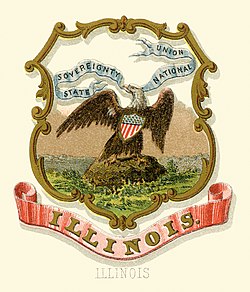 |  | 1818-12-03Statehood – 3 December 1818
Arms – 7 March 1867 [68] |
|---|
| Indiana |  |  | 1816-12-11Statehood – 11 December 1816
Arms – 13 December 1816 [69] |
|---|
| Iowa |  |  | 1846-12-28Statehood – 28 December 1846
Arms – 25 February 1847 [70] |
|---|
| Kansas |  |  | 1861-01-29Statehood – 29 January 1861
Arms – 25 May 1861 [71] [nb 7] |
|---|
| Kentucky |  |  | 1792-06-01Statehood – 1 June 1792
Arms – 20 December 1792 [73] [nb 8] |
|---|
| Louisiana | 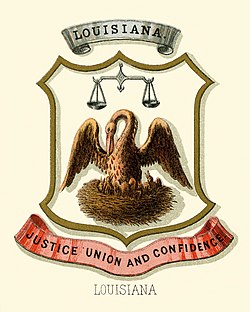 |  | 1812-04-30Statehood – 30 April 1812
Arms – 23 December 1813 [nb 9] [nb 10] |
|---|
| Maine |  |  | 1820-03-15Statehood – 15 March 1820
Arms – 9 June 1820 [77] [78] |
|---|
| Maryland |  |  | 1788-04-28Statehood – 28 April 1788
Arms – 18 March 1876 [77] [nb 11] [nb 12] |
|---|
| Massachusetts |  |  | 1788-02-06Statehood – 6 February 1788
Arms – 13 December 1780 [81] |
|---|
| Michigan |  |  | 1837-01-26Statehood – 26 January 1837
Arms – 2 June 1835 [82] |
|---|
| Minnesota |  |  | 1858-05-11Statehood – 11 May 1858
Arms – 16 July 1858 [83] |
|---|
| Mississippi |  |  | 1817-12-10Statehood – 10 December 1817
Arms – 6 February 1894 [nb 13] |
|---|
| Missouri |  |  | 1821-08-10Statehood – 10 August 1821
Arms – 11 January 1822 [86] [nb 14] |
|---|
| Montana Territory |  |  | 1864-05-26 Organic Act – 26 May 1864 [66]
Arms – 9 February 1865 [88] [nb 15]
Statehood – 8 November 1889 |
|---|
| Nebraska |  |  | 1867-03-01Statehood – 1 March 1867
Arms – 15 June 1867 [90] [nb 16] |
|---|
| Nevada | 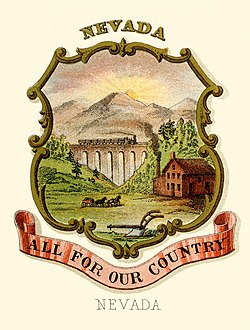 |  | 1864-10-31Statehood – 31 October 1864
Arms – 24 February 1866 [91] |
|---|
| New Hampshire |  |  | 1788-06-21Statehood – 21 June 1788
Arms – 12 February 1785 [92] |
|---|
| New Jersey |  |  | 1787-12-18Statehood – 18 December 1787
Arms – 10 September 1776 [82] [nb 17] |
|---|
| New Mexico Territory |  | | 1912-01-06 Organic Act – 9 September 1850 [60]
Arms – 1 February 1887 [94]
Statehood – 6 January 1912 |
|---|
| New York |  |  | 1788-07-26Statehood – 26 July 1788
Arms – 27 March 1809 [95] |
|---|
| North Carolina |  |  | 1789-11-21Statehood – 21 November 1789
Arms – 1835 [96] |
|---|
| North Dakota | |  | 1889-11-02Statehood – 2 November 1889
Arms – 1 October 1889 [98] |
|---|
| Ohio |  |  | 1803-03-01Statehood – 1 March 1803
Arms – 1 March 1803 [nb 20] |
|---|
| Oregon |  |  | 1859-02-14Statehood – 14 February 1859
Arms – 2 June 1859 [99] |
|---|
| Pennsylvania |  |  | 1787-12-12Statehood – 12 December 1787
Arms – 17 March 1875 [100] |
|---|
| Rhode Island |  |  | 1790-05-29Statehood – 29 May 1790
Arms – 24 February 1875 [101] [nb 21] |
|---|
| South Carolina |  |  | 1788-05-23Statehood – 23 May 1788
Arms – 2 April 1776 [102] |
|---|
| South Dakota | |  | 1889-11-02Statehood – 2 November 1889
Arms – 1 October 1889 [103] |
|---|
| Tennessee | 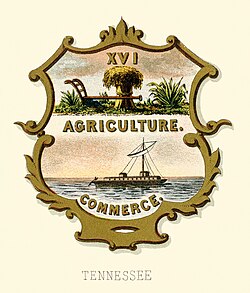 |  | 1796-06-01Statehood – 1 June 1796
Arms – 24 April 1802 [104] [nb 23] |
|---|
| Texas |  |  | 1845-12-29Statehood – 29 December 1845
Arms – 25 January 1839 [105] |
|---|
| Utah Territory | 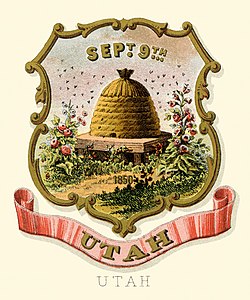 |  | 1850-09-09 Organic Act – 9 September 1850 [60]
Arms – 9 September 1850 [106]
Statehood – 4 January 1896 |
|---|
| Vermont |  |  | 1791-03-04Statehood – 4 March 1791
Arms – 20 February 1779 [107] [nb 24] |
|---|
| Virginia |  |  | 1788-06-25Statehood – 25 June 1788
Arms – 1776 [nb 25] [nb 26] |
|---|
| Washington | |  | 1889-06-04 Organic Act – 2 March 1853 [60]
Arms – 28 February 1854 [111] |
|---|
| West Virginia |  |  | 1863-06-20Statehood – 20 June 1863
Arms – 26 September 1863 [112] [nb 28] |
|---|
| Wisconsin |  |  | 1848-05-29Statehood – 29 May 1848
Arms – 29 December 1851 [113] |
|---|
| Wyoming Territory |  |  | 1868-07-25 Organic Act – 25 July 1868 [114]
Statehood – 10 July 1890 |
|---|
|

































































































